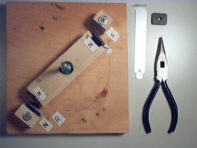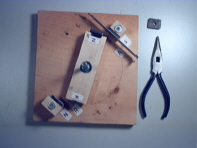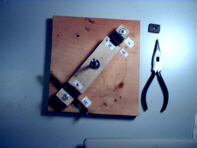The magnetic rotor experiment of Norman Bollinger
|
|
 |
 |
 |
|
Click to view a larger image ! |
||
|
|
 |
 |
 |
|
Click to view a larger image ! |
||
Description of the Rotor
Balancing Experiment
The labels on the rotor show "N" for north poles. The labels on the magnets are "N" in the 7 am position and "S" on the 1 am position. At the 7 am position is an "R" for repelling forces and at the 1 am position is an "A" for attracting. Therefore at the 7 am position there is repelling and on the 1 am position there is attraction which has been carefully balanced by precise adjustments of the stator magnets via the large holes in the wood block and small screws for a sloppy hole adjustment procedure. I. Basically the first thing I do is show that the magnets have no attracting or repelling forces by moving the rotor a bit and not finding any magnetically stuck places. II. Then I place a pc card slot blank (iron) on the 7 am "N" magnet stator. This blocks some of the stator "N" rotor "N" repelling forces making the 1 am attraction no longer balanced so the attracting repelling forces at 1 am position holds the rotor at dead center to the stator "S" magnet. III. Then I take the iron and place it on the 1 am "N" stator magnet. This blocks some of the stator "S" magnet forces making the 7 am repelling forces stronger and therefore no longer balanced. Thus the repelling forces push the rotor away from the 7 am position. My real goal for this project was to find a way to change the permanent magnet forces systematically such that a rotation could be achieved. At first it seemed that a blocker could be inserted and removed with very little effort but embodying that to work was a failed attempt. I still have some hope that this may be done somehow. Maybe you will be the one to do it. I have found that "sticky points" are very difficult to overcome. Magnets in attraction mode want to get closer and closer together and when they get to the closest point they want to stay there. And then they are stuck there and will not leave except with great force. I have made many an apparatus that worked through several cycles but then came the "sticky point" and it stopped. Even the Bedini flux gate does this. It goes several cycles-iterations and then stops at the end.
All it takes is a simple attraction and repelling sequence. But to do that is not easy. Ex. as something approached something else it is attracted and as it leaves it is repelled. This is the way motors work if they are operating with the most efficient design. But the big bugaboo is magnet attraction comes at the cost of the "sticky point" which is probably equal to the work of attraction that we just got. So you want to stay away from attraction which leads to the "sticky point". What is left? Repelling. And that is another whole problem because unless we push the spring it does not release and unless we press the two repelling magnets together then we cannot get any repelling forces to act. And thus the pressing together work is about the same as the desired repelling work. BUT if we can embody a way to systematically block the repelling forces and then restore them at a price that is less than the work gained from the repelling then we are there...... As you may have noticed - that is the direction that my magnetic work has been directed toward. Now - lets do it....